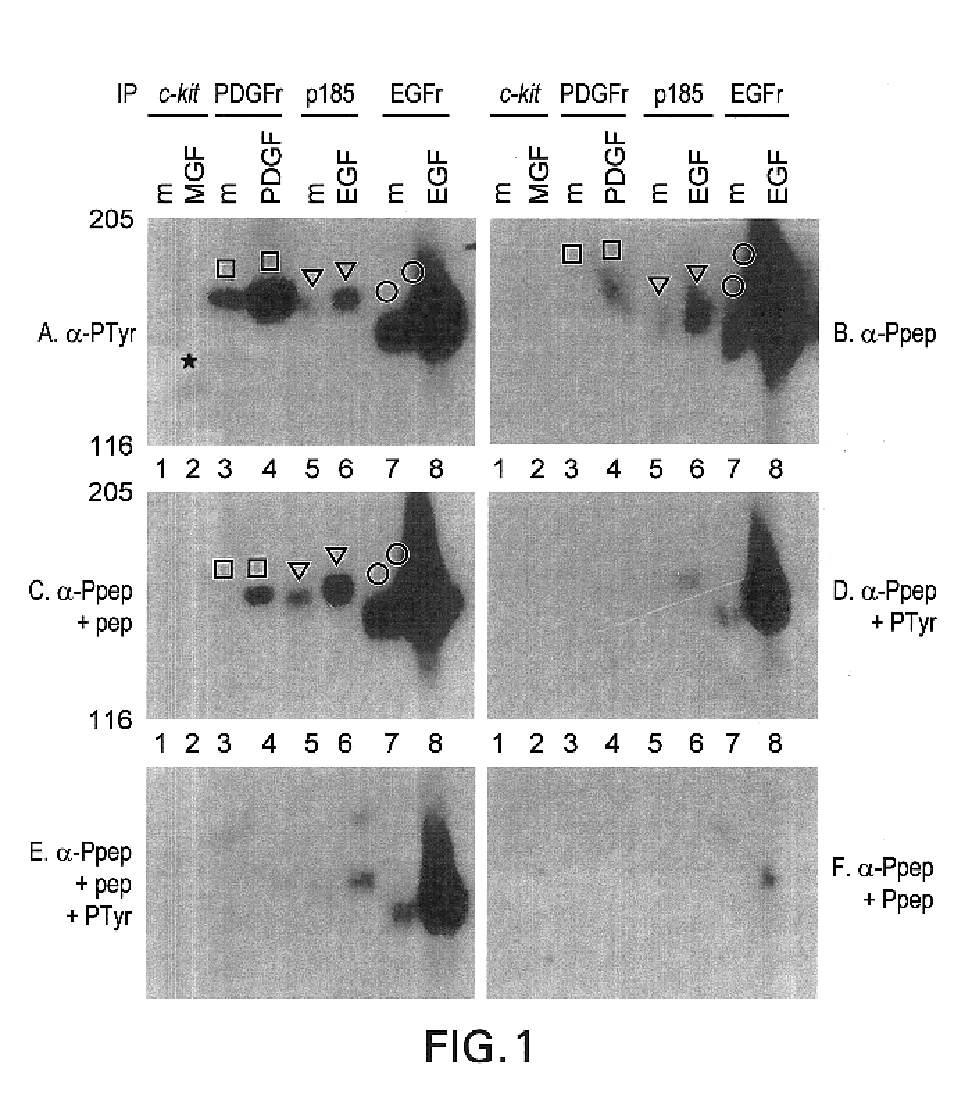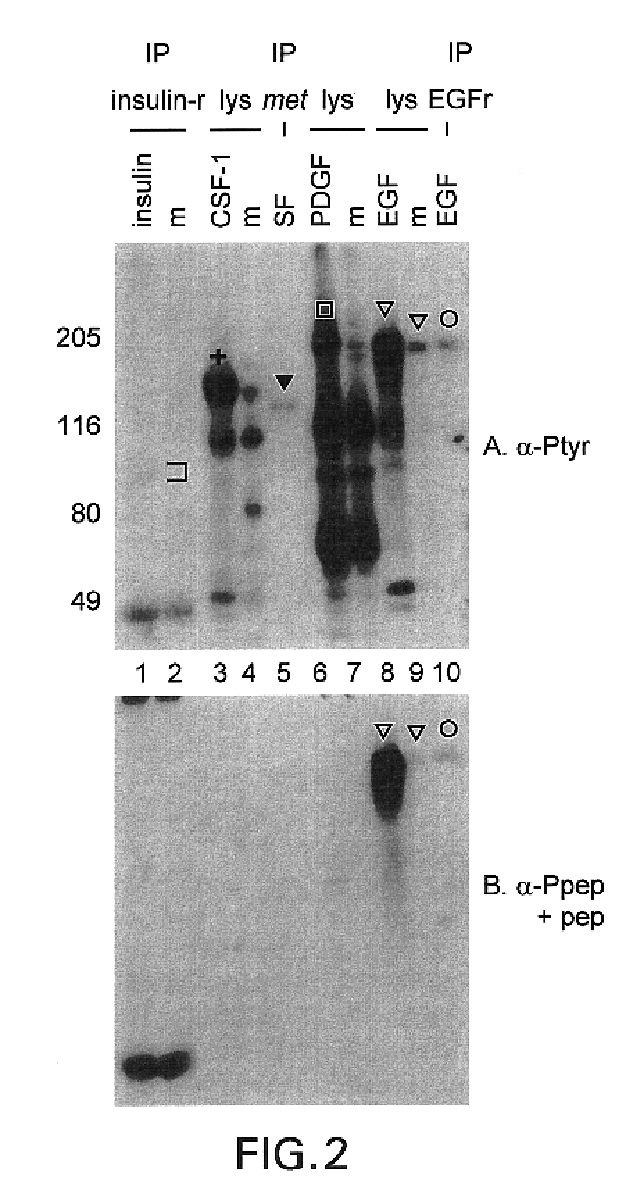Phosphopeptide-specific antibodies that are activity specific; methods of production and antibody uses
a phosphopeptide and activity specific technology, applied in the field of growth regulatory proteins, can solve the problems of insufficient diagnostic methods to reliably predict the subpopulation of nodes, poor clinical course prediction of amplification or overexpression of neu, and neoplastic growth
- Summary
- Abstract
- Description
- Claims
- Application Information
AI Technical Summary
Problems solved by technology
Method used
Image
Examples
example 1
Tyrosine-phosphopeptide-specific Antisera: Anti-pep(P) Production and Purification
[0111]Tyrosine-Phosphopeptide-Specific Antisera. A peptide corresponding to a major autophosphorylation site of human neu was chemically synthesized with Tyr(P) incorporated during synthesis, as follows. The phosphorylation site chosen is located near the C terminus of p185 (Tyr(P)-1248). It is similar in sequence to an autophosphorylation site in the closely related EGFr (TAENPEY*LGLDVPV in human p185 vs. TAENAEY*LRVAPQS in EGFr, where the asterisk indicates the autophosphorylation site) but quite different from major autophosphorylation sites of the PDGF, insulin, and CSF-1 receptors and tyrosine phosphorylation sites of substrates including mitogen-activated protein kinases, phospholipase C-γ, and pp34cdc2 (refs. 36, 44-53; for review, see ref. 54).
(1) Peptide Synthesis. The O-Tyr(P)-containing peptide Lys- Thr-Ala-Glu-Asn-Pro-Glu-Tyr (P)-Leu-[14C]Gly-Leu-Asp-Val-Pro-Val, which corresponds to the ph...
example 2
Tyrosine-phosphopeptide-specific Antisera: Anti-pep(P) Antibody Specificity
A. Materials & Methods. In the following experiments and in later examples, the following reagents and methods were used:
[0113]Cells. NIH 3T3, C127 (obtained from D. DiMaio, Yale University School of Medicine) (24), and FR3T3 are rodent fibroblast cell lines. SK-BR-3 human breast adenocarcinoma cells were obtained from American Type Culture Collection. They have amplified the neu gene and overexpress p185 (13, 25). A431 human epidermoid carcinoma cells have amplified the erbB (EGFr) gene, overexpress the EGFr, and express p185 at moderate levels (ref. 26; D.F.S., unpublished data). The 624 mel human melanoma cells were originally obtained from R. Zakut (National Cancer Institute) (27); pZen cells (originally obtained from L. Rohrschneider) are transfected with a c-fms-encoding plasmid and overexpress the colony stimulating factor 1 (CSF-1) receptor (28); Ya0vBix2NMA cells (29) were obtained from Barry M. Kaci...
example 3
Tyrosine-phosphopeptide-specific Antisera: Anti-pep(P) Antibody Peptide Specificity
[0115]Recognition of Substrates. We next determined whether the anti-Pep(P) serum discriminates against phosphorylated substrates. Protein lysates from CSF-1-treated cells (FIG. 2, lanes 3) and PDGF-treated cells (FIG. 2, lanes 6) contained many anti-Tyr(P) immunoreactive bands besides the receptors. The anti-Pep(P) serum failed to recognize most of the bands in these lysates. Moreover, anti-Pep(P) recognized p185, but not lower molecular weight substrates, in lysates of EGF-treated SK-BR-3 cells (FIG. 2, lanes 8). Anti-Pep(P) and anti-Tyr(P) reacted equivalently with p185 (FIG. 2, lanes 8 and 9) and the EGFr (FIG, 2, lanes 10). However, reactivity with c-met [the scatter factor receptor (FIG. 2, lane 5)], c-fms [the CSF-1 receptor (FIG. 2, lanes 3)], and the insulin receptor (FIG. 2, lanes 1) was greatly reduced or eliminated relative to reactivity with p185 and the EGFr.
[0116]This example and exampl...
PUM
 Login to View More
Login to View More Abstract
Description
Claims
Application Information
 Login to View More
Login to View More - R&D
- Intellectual Property
- Life Sciences
- Materials
- Tech Scout
- Unparalleled Data Quality
- Higher Quality Content
- 60% Fewer Hallucinations
Browse by: Latest US Patents, China's latest patents, Technical Efficacy Thesaurus, Application Domain, Technology Topic, Popular Technical Reports.
© 2025 PatSnap. All rights reserved.Legal|Privacy policy|Modern Slavery Act Transparency Statement|Sitemap|About US| Contact US: help@patsnap.com



